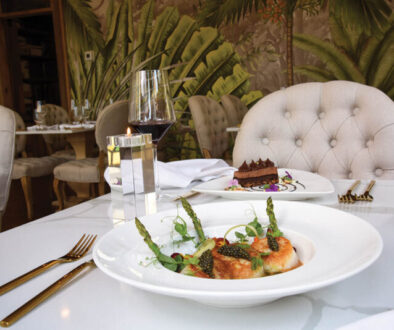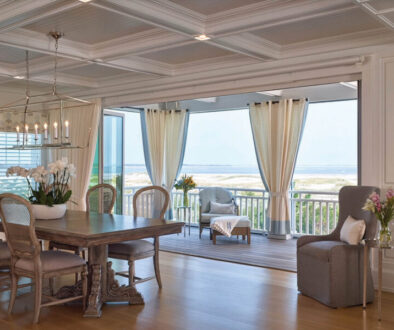203 Perry Street

Step outside The Bayberry House on Perry Street and sip your coffee. Look up or down the block and admire the character of the historic homes lining this picturesque road. Pause on this porch and inhale deeply the ocean breeze that drifts up the street. A more picturesque place for your morning brew would be hard to find. Many folks worked diligently to save this town’s historic essence, and the Cape May community remains deeply committed to protecting its architectural treasures. These community values tend to attract people of a similar mind, including the new owners of The Bayberry House.
“I’m looking out on Perry Street right now and I can’t imagine if some of these houses were clad in vinyl; you wouldn’t have the Cape May you have today,” said Christopher Luce, who along with his wife Michelle purchased the house in January 2022. “The history of these buildings is fascinating, even how they built them. They harvested the wood from local land and then managed to notch them together almost perfectly. Then different fasteners start to appear including box nails, then screws, and with those types of items in the house you can go back and truly analyze how old things really are.”
Today this two-and-a-half story Gothic Revival structure is freshly restored and can host up to 16 guests, with eight bedrooms and six-and-a-half bathrooms. Christopher and Michelle created a new kitchen, added additional bedrooms and bathrooms, and fashioned a more efficient layout. Modern amenities include new central air conditioning, modern TVs, and Wi-Fi. There is that all-important off-street parking and of course that fabulous porch where you will stop to savor this moment of quietude while you admire the aesthetically pleasing streets of Cape May.
“Cape May is a Victorian town, and it was important for us to maintain a blend of the Victorian era with modern elements,” Christopher said. “So, you can’t go 100 percent Victorian and then put in a flat screen TV—it doesn’t look right. But TVs are things we’re accustomed too, and we lead a more streamlined lifestyle. The Victorians liked more opulence—that was a sign of success. But we wanted to tastefully blend the new with the old. That was our objective and I believe we achieved it.”
Christopher, an architect, believes the original part of the structure was a simple cottage which was later enlarged to its current footprint today.
“I believe it was originally built as a whaling captain’s cottage around 1790-ish,” he told us. “That is the back section of the house. Later more was added until it was made into a mansion in the mid-1800s by the mayor of the town, Joseph Q. Williams. The mayor was also a builder and built several other homes around town. There are such great stories to the homes in this town and that has always attracted me to these buildings and their culture.”
City dwellers soon realized it was more pleasant to be by the ocean during hot summer months, and local businessmen soon realized it was more profitable hosting tourists. Hotels popped up along the beachfront, and wealthy Philadelphians built summer homes as testaments to their net worth.
“This home is in the oldest resort town in the nation and that was one of the things that attracted us here. There were several reasons we purchased the house and they all seemed to come together at the right time,” Christopher said. “As an architect, we do a lot of historic preservation and I always like a project. This home also fits as an investment. Perry Street, along with many other streets in town, has homes that were purchased and well-kept. People have made an investment, not only in themselves but also in the town. We love Cape May—it’s a beautiful place.”
According to a 2011 historic survey, this house is a “contributing property in the historic district, because it retains integrity and key character-defining historic features, such as its historic massing, historic wood windows and frames in multiple locations, historic porch structure including decorative posts and cornice, and historic decorative barge boards.”
Regulations about repairing or restoring historical houses have often been controversial in Cape May, observed Chris, such as “Not allowing wooden windows to be replaced with vinyl or allowing or replacing a slate roof with an asphalt roof. It was strict, and it should be. These items of antiquity, of history, if they had been lost in the 80s, they would have been lost forever. Sure, it’s cheaper as a homeowner and more low maintenance, but you lose the character. And we like that Cape May has an appreciation for its treasures—we have the mentality too.”
The Cape May Historic District covers over 380 acres and includes over 600 individual buildings. It was added to the National Register of Historic Places in 1970, and then listed as a National Historic Landmark District in 1976.
“As an architect, it’s almost a museum for me. I can walk down the street and see certain adornments or certain patterns, certain styles and I can guestimate dates,” Chris continued. “It’s so interesting and I suppose the average visitor in Cape May has an appreciation as well. Cape May has such a certain level of history, other towns don’t have that and it’s not the same. And don’t forget all the trees in town.”
And while Cape May might be America’s Oldest Seaside Resort, it may also be America’s best-preserved seaside resort.
“This town is amazing; there are no big national builders coming here and constructing cookie cutters. This town was built, then a large part burned down and things like an old whaler’s cottage swelled into a mansion for the mayor. And this being the mayor’s house I wonder how many people crossed this threshold. How many were famous? Did Lincoln come here? I don’t know, but this house was around at the right time. We love the town; we always enjoy staying here and there’s never a dull moment.” ■



